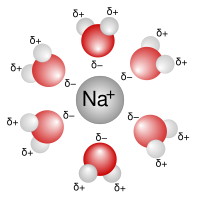
Photo from wikipedia
Abstract An activity-fugacity model is presented to calculate the N2, O2 and Ar solubility in pure water and aqueous electrolyte solutions. It is based on the Pitzer electrolyte theory for… Click to show full abstract
Abstract An activity-fugacity model is presented to calculate the N2, O2 and Ar solubility in pure water and aqueous electrolyte solutions. It is based on the Pitzer electrolyte theory for activity coefficient and an accurate equation of state for the fugacity of vapor phase. The model can accurately calculate the N2 solubility in pure water (273–636 K and 1–600 bar), aqueous NaCl solution (278–398 K, 1–616 bar and 0–6 mol/kg) and aqueous KCl, CaCl2, Na2SO4 and MgSO4 solutions, the O2 solubility in pure water (273–616 K and 0.2–202 bar) and aqueous NaCl, KCl, MgCl2, CaCl2, Na2SO4, K2SO4 and MgSO4 solutions, and the Ar solubility in pure water (273–568 K and 1–127 bar) and aqueous NaCl, KCl, MgCl2 and CaCl2 solutions. The model can not only reproduce the reliable experimental data available, but also can be extended to predict the N2, O2 and Ar solubility in aqueous mixed-salt solution like seawater. The solubility of air in pure water or aqueous NaCl solution can be predicted from this model by the sum of solubility of N2, O2 and Ar in pure water or aqueous NaCl solution, covering a wide range of temperature, pressure and ionic strength. The program for this model can be obtained from the corresponding author ( [email protected] ).
Journal Title: Applied Geochemistry
Year Published: 2019
Link to full text (if available)
Share on Social Media: Sign Up to like & get
recommendations!